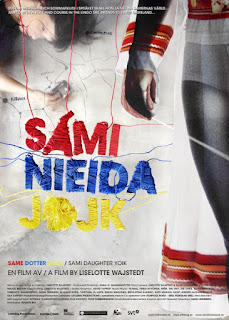This series of posts shares field notes from the study abroad
course "Environment and Society in a Changing Arctic." The course begins
at KTH Royal Institute of Technology in Stockholm, and then students
from the University of Illinois and KTH travel north to conduct research
in the Arctic. This blog was originally posted on KTH's Environment and Society in a Changing Arctic webpage.
by Jessica Sellin and Dan Klen
We learned about the Sami language and how it is verb mobilized rather than noun mobilized, and how this somewhat reflects the Sami lifestyle that emphasizes movement rather than objects. We learned about the pan Sami flag that was introduced in 1986, which has vivid colours influenced by Sami garments (gáhkti) and handicraft as well as the circle in the center representing the circular philosophy of life.
We watched a movie from the Sami webpage www.samer.se, which was supposed to give an introduction to the Sami people. We had a subsequent discussion regarding gender and stereotypes, in which we were critical of the way gender stereotypes perpetuated the male role of reindeer herding. In addition to that, we were concerned about the stereotypical ways in which Sami people are represented, particularly as reindeer herders. We agreed the movie from the Sami website was more similar to an advertisement than a documentary movie aimed for conveying objective information about Sami people and livelihood.
Another film we watched was Sami Nieida Jojk (Sami Daughter yoik), a documentary by Liselotte Wajstedt. The documentary is about a young woman with Sami ancestors; her parents decided not to teach their Sami traditions or language to their daughter. Now she wants to discover the Sami way of living and try to be a part of the Sami community through learning to speak the Sami language, use traditional clothing, and visit Sami festivals. Through camera techniques that made the history viable and personal, Wajstedt displayed her hopes and beliefs on the one hand, and the despairs and lack of faith on the other hand. The documentary rose questions regarding what it means to be a Sami.
At the Nordiska Museet, we focused on the Sápmi exhibition. The exhibition is a mix of media: objects, videos, photography, and text and audio descriptions of the displays. The Museet aims to bring these different media together to give a viewer a holistic story of what it means to be Sami. Clothing, drums, and other objects from Sami cultural history were displayed, and their importance in Sami life communicated through text and audio guides. The exhibition gave us a closer look at the culture we’ve been studying in lectures and how that culture is represented in a cultural institution. Learning more about the Sami prepares us to engage with them in person and become more knowledgeable about their perspectives and values, which is particularly important because we will be heading to Kiruna in less than a week to begin our fieldwork. We ended our tour of the exhibition with a discussion about how the Sami are represented and left the Museet with much to think about as the class goes forward.







0 comments:
Post a Comment